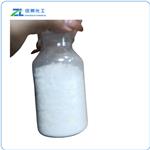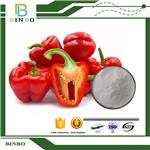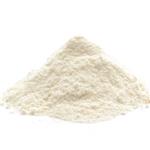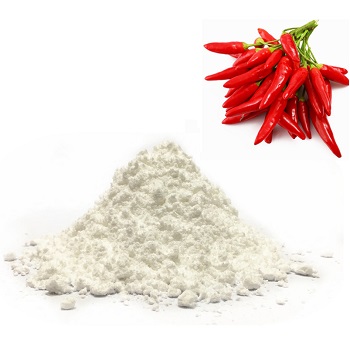- Capsaicin
-

- $70.00 / 1kg
-
2025-04-02
- CAS:404-86-4
- Min. Order: 1kg
- Purity: 99
- Supply Ability: 5000
- Capsaicin
-

- $0.00 / 1kg
-
2025-04-02
- CAS:404-86-4
- Min. Order: 1kg
- Purity: 99.8%
- Supply Ability: 1000 kg
- CAPSAICIN
-

- $120.00 / 1kg
-
2025-04-02
- CAS:404-86-4
- Min. Order: 1kg
- Purity: 0.99
- Supply Ability: 1000000
|
| | Capsaicin Chemical Properties |
| Melting point | 62-65 °C(lit.) | | Boiling point | 210-220 C | | density | 1.1037 (rough estimate) | | refractive index | 1.5100 (estimate) | | FEMA | 3404 | CAPSAICIN | | Fp | 113 °C | | storage temp. | 2-8°C | | solubility | H2O: insoluble | | form | Off-white solid | | pka | 9.76±0.20(Predicted) | | color | Off-white | | Odor | mild warm herbal | | Odor Type | herbal | | biological source | Capsicum sp. | | Water Solubility | insoluble | | Merck | 14,1768 | | BRN | 2816484 | | Stability: | Stable. Incompatible with strong oxidizing agents. | | InChIKey | YKPUWZUDDOIDPM-SOFGYWHQSA-N | | LogP | 4.00 | | CAS DataBase Reference | 404-86-4(CAS DataBase Reference) | | EPA Substance Registry System | Capsaicin (404-86-4) |
| | Capsaicin Usage And Synthesis |
| Description | Capsaicin is the main chemical that makes chili peppers hot. Capsaicin is an animal repellent that is also used against insects and mites. Capsaicin was first registered for use in the United States in 1962. The U.S. Environmental Protection Agency considers it to be a biochemical pesticide because it is a naturally occurring substance.

The chemical compound capsaicin (8-methyl-N-vanillyl-6-nonenamide) is the active component of chili peppers, which are plants belonging to the genus Capsicum. It is an irritant for mammals, including humans, and produces a sensation of burning in any tissue it comes in contact with. Capsaicin and several related compounds are called capsaicinoids and are produced as a secondary metabolite by chili peppers, probably as deterrents against herbivores. Pure capsaicin is a hydrophobic, colorless, odorless, crystalline to waxy compound.
| | History | Capsaicin is a naturally occurring substance that is responsible for the burning, pungent sensation associated with the ingestion of hot peppers from the Capsicum genus. The effect elicited by these peppers is at the origin of the name Capsicum, which derives from the Greek kapto, meaning “to bite”.
Hot peppers are a native plant from the American tropics and their use can be traced back to the Aztec and Inca civilizations. The Aztecs named them “chilies” and used them for culinary purposes. After discovery of the New World, chili pods were introduced in Europe and their cultivation expanded to other parts of the globe. Nowadays, hot peppers are found in nearly every country and are an important part of the culinary tradition of many different cultures.
The active component of chili peppers was initially isolated by J. C. Thresh in 1846. The compound was named “capsaicin” and its chemical structure was later determined by E. K. Nelson in 1919. The complete chemical synthesis of 8-methyl-N- vanillyl-6-nonenamide (capsaicin’s IUPAC* name) was reported in 1930 by Spath &Darling. In the 1960’s, Japanese investigators identified additional substances from Capsicum extracts with similar chemical and pharmacological properties that were termed “capsaicinoids”. Currently, this family of chemical analogues includes both natural (homodihydrocapsaicin, dihydrocapsaicin, nordihydrocapsaicin, homocapsaicin and capsaicin) and synthetic (nonivamide) members.
| | Uses | Capsaicin is what makes chili peppers hot. It is an irritant.for mam- mals, but not for birds. This may be because birds spread the seeds better than mammals. It causes a burning sensation in any mam- malian tissue with which it comes in contact.
Capsaicin is a nonpolar molecule; it dissolves in fats and oils, not in water. This is why water does not take away the burning sensation, but whole milk or other fat-containing liquids or foods will.
As an ingredient in medicines, capsaicin is used to relieve pain from arthritis, muscle aches, and sprains. It is a rubefacient, meaning it dilates blood vessels. The heat effect overwhelms nerves, causing a localized numbing sensation.
Capsaicin is also used in pepper spray. | | Application in Particular Diseases | In Osteoarthritis:
- Capsaicin, an extract of red peppers that causes release and ultimately depletion of substance P from nerve fibers, has been beneficial in providing pain relief in OA when applied topically over affected joints. It may be used alone or in combination with oral analgesics or NSAIDs.
- To be effective, capsaicin must be used regularly, and it may take up to 2 weeks to work. It is well tolerated, but some patients experience temporary burning or stinging at the site of application. Patients should be warned not to get the cream in their eyes or mouth and to wash their hands after application.
- Application of the cream, gel, or lotion is recommended four times daily, but tapering to twice-daily application may enhance long-term adherence with adequate pain relief.
| | Description | Capsaicin has a mild, warm-herbaceous odor and a burning pungent taste (at 10 ppm). It is used in compounded flavors for sauces where the pungent note is desired. This substance is present in several species of Capsicum (Family, Solanaceae). The sensation of pain, accompanied by irritation and inflammation, is due to substance P depletion from sensory (afferent) nerve fibers. These properties are used to study the physiology of pain and the effects as a counterirritant and gastrointestinal stimulant. This substance may be prepared from 3-chloro-2-isopropyltetrahydropyran; biosynthesis from Capsicum frutescens; separation form cis-capsaicin, pelargonic acid vanilamide, and dihydrocapsaicin, reaction of capsaicin. | | Description | Capsaicin is a terpene alkaloid that has been found in Capsicum and has diverse biological activities. It induces inward currents in HEK293 cells expressing rat transient receptor potential vanilloid 1 (TRPV1; EC50 = 0.64 μM at neutral pH), an effect that can be blocked by the TRPV1 inhibitor A-425619. Capsaicin (10 and 50 μM) decreases LPS-induced prostaglandin E2 (PGE2; ) production, as well as reduces LPS- and IFN-induced nitric oxide (NO) release in isolated mouse peritoneal macrophages. Capsaicin induces substance P release in rat spinal cord slices with an EC50 value of 2.3 μM. It reduces acetylcholine- or phenylquinone-induced writhing (ED50s = 1.33 and 1.38 mg/kg, respectively, s.c.) but has no effect on the latency to paw withdrawal in the hot plate test in mice (ED50 = >20 mg/kg, s.c.). Formulations containing capsaicin have been used in the treatment of nerve pain associated with shingles. | | Chemical Properties | Crystalline solid, rectangular plates, or scales.
Pungent odor and burning taste. | | Chemical Properties | N-(4-Hydroxy-3-methoxybenzyl)-8-methyl-6-nonenamide has a mild, warm-herbaceous odor and burning, pungent
taste (10 ppm). It is used in compounded flavors for sauces where the pungent note is desired. | | Chemical Properties | Off-White Crystalline Solid | | Physical properties | Appearance: crystalline white powder, with highly volatile and pungent odor.
Solubility: freely soluble in alcohol, ether, benzene, and chloroform; slightly soluble
in carbon disulfide, petroleum, and hydrochloric acid; insoluble in water. Melting
point: 65?°C. | | Occurrence | The pungent principle in the fruits of various Capsicum species (Solanaceae) | | History | In 1816, Christian Friedrich Bucholz (1770–1818) first carried out the purification
of capsaicin. He obtained incompletely purified capsaicin and named it “capsaicin”
. In 1876, John Clough Thresh (1850–1932) further purified and got pure capsaicin and named it capsaicin. In 1919, Nelson identified the capsaicin structure. In 1930, E.?Spath and S.?F. Darling used chemical synthesis method for the first
time to successfully synthesize capsaicin. In 1961, the Japanese chemists
S.? Kosuge and Y.? Inagaki isolated similar substances from capsicum and named
them capsaicinoids.
More than 14 capsaicin homologues have been found till now, the structures are
similar with capsaicin, and the typical structure is H3CO(HO)-C6H3-CH2-NHCO-R, which is only different from R group. Capsaicin is the highest content in chili
pepper. Capsaicin and dihydrocapsaicin are the most potent active substances in
capsicum. Capsaicin and its analogues have been synthesized in large quantities in
practice and can be used not only in medicine but also in agriculture and industry.
Although there is a long history of pharmacological and chemical studies on
capsaicin, until November 16, 2009, the US Food and Drug Administration (FDA)
approved the first containing high concentration capsaicin prescription Qutenza
(8% capsaicin) patch for the treatment of postherpetic neuralgia. At present, most
countries have capsaicin prescription drugs on market, but clinical indications are
limited in the treatment of pain. | | Uses | analgesic (topical), depletes Substance P, neurotoxic | | Uses | A representative lot is a 5:1 E:Z mixture.
It is used as a tool in neurobiological research. Prototype vanilloid receptor agonist. Topical analgesic. | | Uses | K channel blocker; multiple sclerosis therapy | | Uses | Capsaicin is used in many topical ointments used to relieve the pain of peripheral neuropathy (treatment of pain in the nerve endings near the surface of the skin). | | Uses | Capsaicin analogue (C175680). It is used as a tool in neurobiological research. Prototype vanilloid receptor agonist. Topical analgesic. | | Definition | ChEBI: Capsaicin is a capsaicinoid. It has a role as a non-narcotic analgesic, a voltage-gated sodium channel blocker and a TRPV1 agonist. | | Indications | Capsaicin (Zostrix) is approved for the relief of pain
following herpes zoster infection (postherpetic neuralgia).
The drug depletes neurons of substance P, an endogenous
neuropeptide that may mediate cutaneous
pain. It is applied to affected skin after open lesions
have healed. Local irritation is common. | | General Description | Capsaicin occurs as the active ingredient of hot/red pepper and was first obtained by Thresh in 1846. It is a lipophilic vanilloid compound responsible for the acrid taste of hot peppers. | | Biological Activity | Prototypic vanilloid receptor agonist (pEC 50 values are 7.97 and 7.10 at rat and human VR1 receptors respectively). Excites a subset of primary afferent sensory neurons, with subsequent antinociceptive and anti-inflammatory effects. Reversibly inhibits aggregation of platelets. Also available as part of the Vanilloid TRPV1 Receptor Tocriset™ . | | Biochem/physiol Actions | Prototype vanilloid receptor agonist. Neurotoxin; activates sensory neurons that give rise to unmyelinated C-fibers, many of which contain substance P. Topical application desensitizes the sensory nerve endings giving a paradoxical antinociceptive effect; systemic administration can be neurotoxic to capsaicin-sensitive cells, especially in newborn animals. Active component of chili peppers. | | Pharmacology | Hbgyes, A. (1878) first reported that capsaicin has a strong stimulating effect,
which is the first pharmacological study on capsaicin. And then, a serial of pharmacological effects were discovered. The discovery of capsaicin receptor further
explains the mechanism of capsaicin. The capsaicin receptor, also known as transient voltage receptor cation channel V1 (TRPV1), is a nonselective ligand-gated
cation channel. TRPV1 is widely distributed in the body, mainly in sensory neurons,
and can also be activated by heat and friction damage.
Studies on the analgesic effect of capsaicin were carried out earlier and more
thoroughly. Capsaicin can act on sensory nerve C primary afferent fibers, bind the
end of the neuronal TRPV1 receptor. Capsaicin (1?μM) can result in inward calcium
influx, cell depolarization, neuronal excitation, and glutamate release. The sustained neuron excitement and then failure can result in analgesic and antipruritic
effects.
The mutation of the capsaicin receptor can not only induce obesity but also may
be associated with the occurrence of diabetes. Capsaicin can activate and recruit
brown fat to prevent obesity. Brown fat can produce non-shivering heat in cold
environment and participate in energy consumption. A 10–130?mg daily capsaicin
can significantly increase the body’s energy and fat consumption.
Capsaicin also has a protective effect on the cardiovascular system. Treatment of
capsaicin with rats at a dose of 15?mg/kg can not only promote animal blood circulation and strengthen the cardiovascular function but also reduce the blood pressure
, the serum cholesterol, and triglyceride levels.
The study result of capsaicin on tumor is still controversial. The epidemiology
and basic research have suggested that capsaicin can not only be used as a carcino400
gen but also can prevent cancer. It has been shown that capsaicin can induce cancer
cell apoptosis, and animal experiments have shown that prolonged use of capsaicin
on the skin can induce skin cancer.
Capsaicin is able to scavenge free radicals and inhibit oxidative stress. Capsaicin
can promote gastric secretion, increase appetite, relieve flatulence, improve digestive function, and also prevent gastrointestinal infection and diarrhea. Capsaicin can
improve the performance of sports and anti-fatigue. Capsaicin is capable of thinning
lung mucus, in favor of sputum discharging, enhancing lung tissue perfusion, and
preventing and treating emphysema. Capsaicin is also beneficial on psoriasis, frostbite, cold, etc. In addition, capsaicin is also used for the paralysis of peripheral
nerve function for hypertension treatment.
Capsaicin can be absorbed by the intestine and skin and is able to pass through
the blood-brain barrier. | | Clinical Use | In clinical practice, capsaicin is mainly used for topical administration, such as in
the treatment of osteoarthritis and rheumatoid arthritis pain, diabetic nerve pain,
pain after surgery, chemotherapy- or radiotherapy-induced oral pain, psoriasis, etc.
Capsaicin irritates the mucous membrane to cause sneezing, nose bleeding,
coughing, mucus secretion, tears, bronchoconstriction, breathing difficulties, and
other symptoms. The main adverse effects of capsaicin preparations are contact
dermatitis, skin inflammation or blisters, and in severe situation burn-like lesion. | | Anticancer Research | Capsaicin is the major pungent ingredient in red and green chili pepper. It is reportedto induce apoptosis selectively in cancer cells and can suppress the activation ofNF-κB through suppression of NF-κB inhibitor IκBα (Aggarwal and Shishodia 2004). It shows anticancer effects in animal models and suppresses carcinogenesisin colon, skin, lung, tongue, and prostate cancers by altering the metabolism ofcarcinogens. It selectively suppresses the human cancer cell growth of prostate,leukemic, glioma, gastric, and hepatic cancers. It inhibited the tumorigenesis linkedand IL-6-induced activation of STAT-3 and STAT3-regulated gene products likecyclin D1, Bcl-2, Bcl-xL, survivin, and VGEF. It arrests cells in G1 phase andinduces apoptosis (Aggarwal et al. 2008; Clark and Lee 2016). | | Synthesis | From 3-chloro-2-isopropyltetrahydropyran; biosynthesis from Capsicum frutescens; separation from cis-capsaicin, pelar�gonic acid vanillamide and dihydrocapsaicin; reaction of capsaicin | | Potential Exposure | Botanical animal and insect repellent
used to repel birds, voles, deer, rabbits, squirrels, insects,
and attacking dogs. Capsaicin, which is made from the
Capsicum red chili pepper can be used indoors to protect
carpets and upholstered furniture, and outdoors to protect
fruit and vegetable crops, flowers, ornamental plants,
shrubbery, trees, and lawns. It is also used in pepper sprays
such as MACE, and as an analgesic in creams, lotions and
solid sticks to reduce arthritic, postoperative and neuopathic
pain, such as shingles. Capsaicin is obtained by grinding
dried, ripe Capsicum frutescens L. chili peppers into a fine
powder. The oleoresin is derived by distilling the powder
in a solvent and evaporating the solvent. The resulting
highly concentrated liquid has little odor but has an
extremely pungent taste | | storage | Room temperature | | Shipping | UN2811 Toxic solids, organic, n.o.s., Hazard
Class: 6.1; Labels: 6.1-Poisonous materials, Technical
Name Required. | | Purification Methods | Recrystallise capcaicin from pet ether (b 40-60o), or pet ether/Et2O (9:1). Also purify it by chromatography on neutral Al2O3 (grade V) and elute successively with *C6H6, *C6H6/EtOAc (17:3) then *C6H6/EtOAc (7:3), and distil it at 120o/10-5mm, then repeatedly recrystallise the needles from isopropanol (charcoal). [Crombie et al. J Chem Soc 11025 1955, Bennett & Kirby J Chem Soc(C) 442 1968.] It causes pain and is neurotoxic [Bevan & Szolcsanyi Trends in Pharmacol Sci 11 330 1990, Beilstein 13 IV 2588]. | | Incompatibilities | Slowly hydrolyzes in water, releasing
ammonia and forming acetate salts. | | Waste Disposal | Do not discharge into drains
or sewers. Dispose of waste material as hazardous waste
using a licensed disposal contractor to an approved landfill.
Consult with environmental regulatory agencies for guidance on acceptable disposal practices. Incineration with
effluent gas scrubbing is recommended. In accordance
with 40CFR165, follow recommendations for the disposal
of pesticides and pesticide containers. Noncombustible containers should be crushed and buried under more than
40 cm of soil. Must be disposed properly by following
package label directions or by contacting your local or federal environmental control agency, or by contacting your
regional EPA office | | References | 1) Gunthorpe et al. (2002) The diversity in the vanilloid (TRPV) receptor family of ion channels; Trends Pharmacol. Sci. 23 183
2) Van Der Stelt and Di Marzo (2004) Endovanilloids. Putative endogenous ligands of transient receptor potential vanilloid 1 channels; Eur. J. Biochem. 271 1827
3) Perkins and Campbell (1992) Capsazepine reversal of the antinociceptive action of capsaicin in vivo; Br. J. Pharmacol. 107 329
4) Kim et al..(2003) Capsaicin exhibits anti-inflammatory property by inhibiting IkB-a degradation in LPS-stimulated peritoneal macrophages; Cell. Signal., 15 299
5) Di Marzo et al. (2001) Hypolocomotor effects in rats of capsaicin and two long chain capsaicin homologues; Eur. J. Pharmacol., 420 123 |
| | Capsaicin Preparation Products And Raw materials |
|